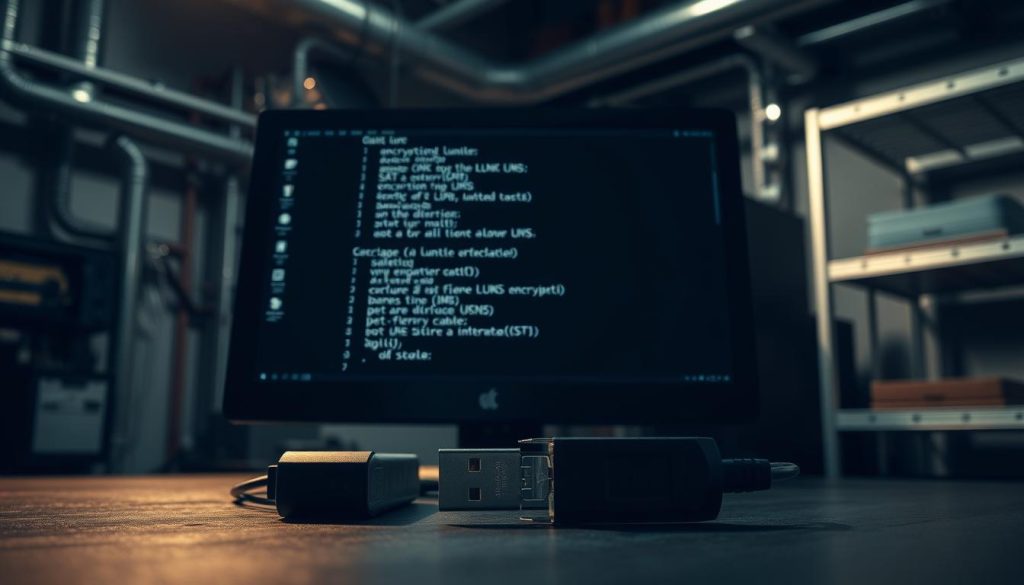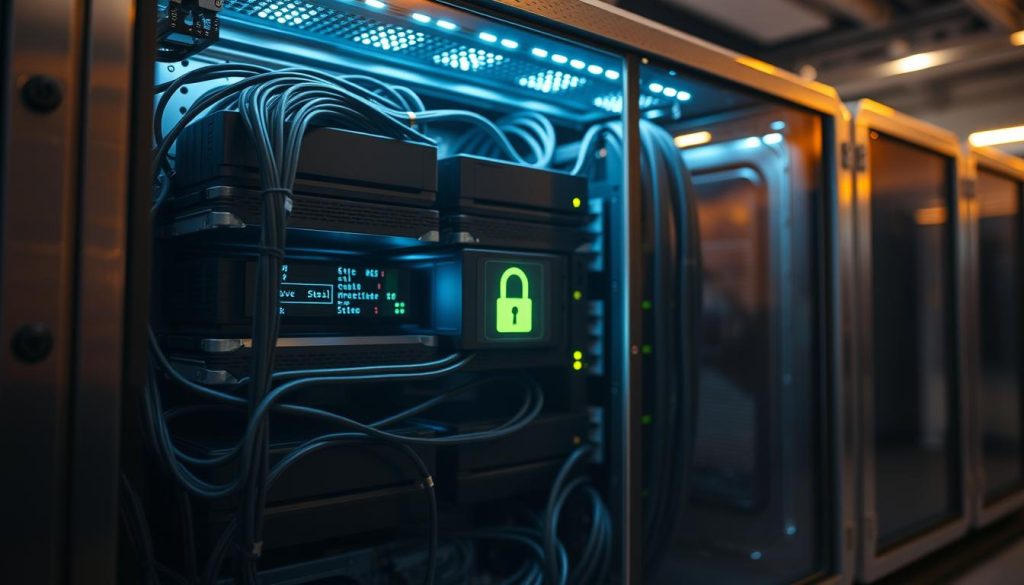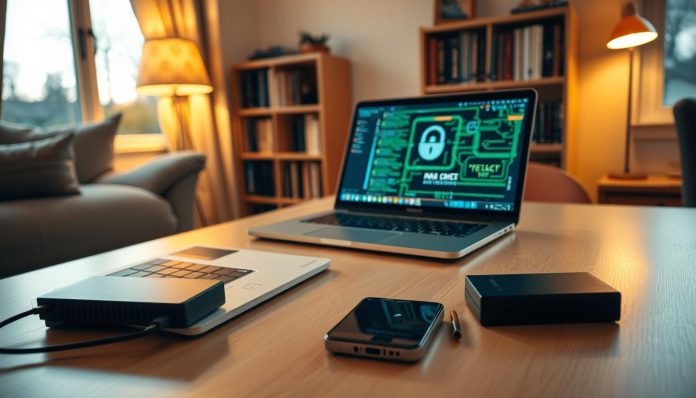Data breaches make headlines and remind you that your personal files can be at risk. Stories about Target, Equifax, and Yahoo show how exposed information can become. A report from the Advanced Cyber Security Center found many consumers do not know which tools protect their data.
This guide puts control back in your hands. You will learn how to protect your computer, accounts, and backup files with clear steps. The goal is practical: simple options you can enable in minutes using built-in software or a trusted service.
We cover the process for Windows, macOS, and Linux. You will see how full-disk protection, folder-level measures, and offsite backup choices fit into one system. We also explain how to create recovery keys and store them safely so you keep access when you need it most.
Key Takeaways
- You gain control: strong protection keeps your information private even if hardware is lost.
- Learn step-by-step actions for major operating systems.
- Compare built-in software and paid service options to match your needs.
- Include recovery key practices to avoid losing access to your account.
- Apply solutions across internal and external storage for a complete system.
What “Encryption at Home” Means and Why It Protects Your Privacy Now
Think of your laptop or phone as a locked box: without the key, nothing inside makes sense. Encryption turns your files into unreadable data that only you can open with a password or key. This gives you control when a device is lost, stolen, or recycled.
How it safeguards privacy: the process blocks unauthorized access even if someone removes the hard drive and plugs it into another system. It protects passwords, Wi‑Fi settings, browsing history, and sensitive app data during restores.
The operating system often offers built-in options you can enable in a single step. That quick change strengthens security across the entire system, from the disk to external drives you keep in a box.
Expect clear results once enabled: you log in as usual, but the drive and backups stay locked when power is off. Use this solution with strong passwords, regular updates, and careful key storage to keep protection effective for years.
- What gets protected: whole disks, partitions, or user profiles.
- What to check: verification tools in your operating system to confirm status.
- Everyday scenarios: lost laptops, sold computers, or phones on your home network—encryption prevents misuse.
How to Encrypt Your Computers: Windows Device Encryption, BitLocker, and macOS FileVault
Before you start, confirm your system meets the requirements for built‑in drive protection. This lets you pick the easiest path for your windows machine or a Mac. Small checks save time and prevent mistakes.

Windows 11/10 Device Encryption: Check support and turn it on
Open System Information as an administrator and look for Device Encryption Support. If the results read “Meets prerequisites,” the device option is available.
Go to Settings > Privacy & Security (or Update & Security on Windows 10) > Device encryption and choose Turn on. Let the drive encrypt in the background while you keep the computer powered.
When Device Encryption isn’t available: Enable BitLocker on Pro editions
If the settings require a Microsoft account or the quick option is missing, use BitLocker on Windows 11 Pro or 10 Pro. Open Manage BitLocker from Control Panel or search, then choose Turn on BitLocker for your system drive.
Back up the recovery key to your Microsoft account, save it to a USB or file stored off the box, or print it. Confirm your BitLocker options, activate, and allow the hard drive to finish encryption.
macOS FileVault: Turn on full disk protection and manage users
On a Mac, go to System Preferences > Security & Privacy > FileVault and unlock with an administrator account. Click Turn On FileVault and enable any additional user who must unlock the disk.
Choose either an iCloud recovery or a local key. Document that recovery key off the computer and treat it like a password: it is your final answer if login fails.
Recovery keys and secure storage: Generate, verify, and keep them off the device
Recovery key hygiene matters. Always generate a recovery key, verify it works, and store it separately from the system. If you lose both password and key, access to data is gone.
- Keep one backup copy in a secure physical location and one in a trusted cloud account tied to your user account.
- Ensure TPM, Secure Boot, and WinRE settings are configured on windows machines to avoid availability issues.
- Update system software and firmware so the disk protections remain reliable.
Linux Storage Security: LUKS, LVM, and Home Folder Encryption Options
For a secure Linux setup, plan to apply LUKS with LVM when you install the operating system. LUKS is the de facto standard for encrypting block devices on major linux distributions. Pairing it with the Logical Volume Manager gives flexible volume layout while keeping every partition inside the encrypted container.
Why enable this during install: the installer creates the encrypted partition first, then layers the filesystem or manager on top. Trying to retrofit whole‑disk protection later is risky because the process expects to initialize the partition before building the logical volumes.
If you cannot reinstall, you can protect your personal folder with eCryptfs. Install the required packages with sudo apt-get install ecryptfs-utils cryptsetup. Then log out of the target account, sign in as another user, and run sudo ecryptfs-migrate-home -u user.
Immediately log back into the migrated account to capture the generated passphrase. Use ecryptfs-unwrap-passphrase if you need to view it later. Encrypt swap as well and keep recovery phrases offline. After two normal reboots, remove the unencrypted backup under /home to avoid leaving a plain file copy on the hard drive.

| Option | When to use | Pros | Cons |
|---|---|---|---|
| LUKS + LVM | During OS install | Full coverage, flexible volume management | Requires reinstall to apply safely |
| eCryptfs (home) | Post‑install migration | Targets user folder, less disruptive | Leaves system partition unprotected |
| Encrypt secondary hard drive | Any time | Protects extra drives without reinstall | Management overhead, key storage required |
Encryption at Home: Encrypting Storage, Devices & Backups
A good backup plan keeps your passwords, app data, and photos safe when hardware fails or you upgrade.
Why encrypt backups: Control, privacy, and safer restores
Encrypted copies give you control so a lost phone or failed drive does not expose passwords or personal files. They also let you perform full restores that include account tokens and Wi‑Fi details.
iTunes encrypted backups: What’s included, setup, and common caveats
iTunes can create an encrypted backup that stores passwords, Wi‑Fi settings, browsing history, and Health/Activity data. Connect the device, enable the Encrypt backup option, and keep a secure copy of the password used.
“An encrypted iTunes backup preserves more app and system information than a standard copy.”
Acronis True Image: Automatic, wireless encrypted copies and cloud security
Acronis runs scheduled, wireless copies that encrypt files locally, in transit, and at rest in the cloud. You can set it to start over your home network so the process happens without manual steps.
| Option | Automation | Includes passwords | Offsite option |
|---|---|---|---|
| iTunes encrypted copy | No (manual connect) | Yes | No (use separate cloud) |
| Acronis True Image | Yes (wireless) | Yes | Yes (Acronis Cloud) |
| Local drive + offsite copy | Varies | Depends on tool | Yes (physical location) |
Follow the 3-2-1 rule and phone upgrades
Keep three copies on two types of media with one copy in another location. Store recovery details securely and test a restore so you know access works when you need it.

Conclusion
Conclude by verifying each computer and backup location is protected and recoverable. Enable full‑disk protection on Windows or macOS, generate the recovery key, and store that key off the computer in a trusted place. Confirm your windows setup can return the key to your account when needed.
Keep your process simple. Keep FileVault enabled for every user who must unlock the disk. Make sure your backups are encrypted, follow a 3‑2‑1 plan, and run periodic test restores so files and information are accessible when you need them.
Document where keys live, standardize on built‑in tools and a single backup service, check drive health over time, and train household members on the restore steps. Do this once, then revisit after major updates — you’ll finish with confidence and practical protection.

